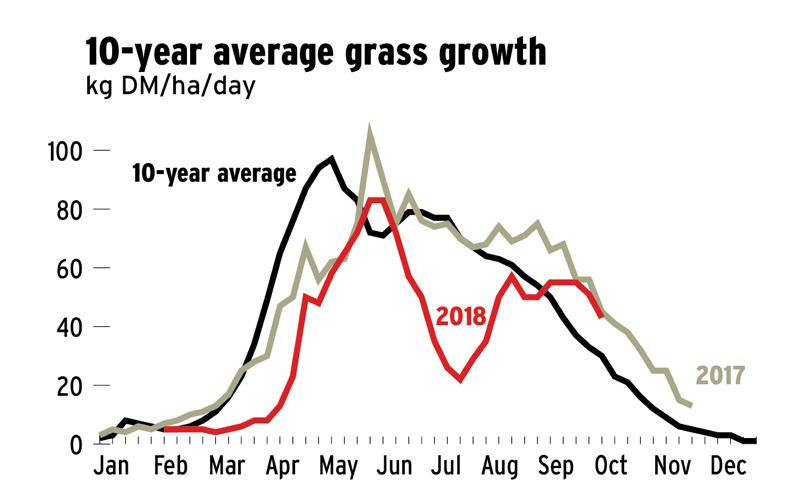The national average growth rate has only dropped 7kg DM/ha/day for the last four weeks meaning it is giving farmers every chance this autumn.
Growth is holding firm. Currently, the national average growth rate is at 45kg DM/ha/day, down slightly from last week. Thankfully, the weather is playing ball at the moment for farmers across the country and conditions are ideal for grazing. As we now enter the final rotation on most grazing platforms, one of the key things should be to graze tightly to ensure a clean regrowth before the winter – ground conditions should allow for this at the moment. This summer’s drought is well and truly in the past and the only yellow that remains on grassland is as a result of silage cutting, something that has been plentiful over the last 10 days.
Silage
Most of the crops being cut are those second cuts that were grazed during the middle of the drought as growth stalled and grass got scarce, while some crops are quickly-grown third cuts which were taken up after poor yielding second cuts. Either way, it is a notoriously difficult time of the year for silage cutting, with grass quality dropping every day as daylight hours and temperatures drop.
So what can we expect from silage at this time of the year compared with conventional summer silage? Firstly, due to the shorter periods of daylight, grass sugars will be down. Grass fibre will also be down as the annual growth curve of the grass plant has long passed its heading-out date. As a result, proper fermentation will be more challenging. In certain cases, additives have been used. Where not used, ensure preservation is completed carefully. For bales, avoid stacking. Bales made at a low DM or from very lush grass will lose shape when stacked, increasing spoilage losses.
Given the year that has just passed, and provided that silage pits and bale pads are maybe not as full as we might like them to be, silage sampling can play a very significant role this winter, particularly where quality will vary highly between silage cut at the start of the summer and silage cut in the last 10 days. Ideally, silage should be left six weeks before sampling, but where time is running out, the majority of fermentation happens in the first three weeks.


Read more
Grass+: grazing conditions couldn't be better
The national average growth rate has only dropped 7kg DM/ha/day for the last four weeks meaning it is giving farmers every chance this autumn.
Growth is holding firm. Currently, the national average growth rate is at 45kg DM/ha/day, down slightly from last week. Thankfully, the weather is playing ball at the moment for farmers across the country and conditions are ideal for grazing. As we now enter the final rotation on most grazing platforms, one of the key things should be to graze tightly to ensure a clean regrowth before the winter – ground conditions should allow for this at the moment. This summer’s drought is well and truly in the past and the only yellow that remains on grassland is as a result of silage cutting, something that has been plentiful over the last 10 days.
Silage
Most of the crops being cut are those second cuts that were grazed during the middle of the drought as growth stalled and grass got scarce, while some crops are quickly-grown third cuts which were taken up after poor yielding second cuts. Either way, it is a notoriously difficult time of the year for silage cutting, with grass quality dropping every day as daylight hours and temperatures drop.
So what can we expect from silage at this time of the year compared with conventional summer silage? Firstly, due to the shorter periods of daylight, grass sugars will be down. Grass fibre will also be down as the annual growth curve of the grass plant has long passed its heading-out date. As a result, proper fermentation will be more challenging. In certain cases, additives have been used. Where not used, ensure preservation is completed carefully. For bales, avoid stacking. Bales made at a low DM or from very lush grass will lose shape when stacked, increasing spoilage losses.
Given the year that has just passed, and provided that silage pits and bale pads are maybe not as full as we might like them to be, silage sampling can play a very significant role this winter, particularly where quality will vary highly between silage cut at the start of the summer and silage cut in the last 10 days. Ideally, silage should be left six weeks before sampling, but where time is running out, the majority of fermentation happens in the first three weeks.


Read more
Grass+: grazing conditions couldn't be better








 This is a subscriber-only article
This is a subscriber-only article









SHARING OPTIONS: